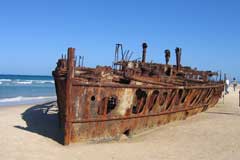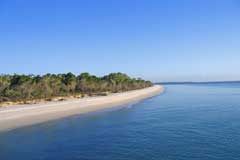Fraser Island General Information
Magnificent World Heritage Fraser Island, a unique wilderness!Facts About Fraser Island
Fraser Island is
situated just off the south Queensland coast opposite Hervey
Bay. The island is about 120 kilometres long and between 5 and
25 kilometres wide.
Dozens of lakes, rainforest and huge sandblows cover vast parts
of the island. People who visit Fraser Island for the first time
often struggle to find the words to describe the beauty of this
magical island. But also animal life, especially the 230 species
of birds, Australia's purest dingo's and many other species
contribute to the unique island environment.
Aboriginals of the Butchulla tribe have been living on Fraser
Island for the last 5000 years. And because the abundance of
food supplied by the sea, the lakes and the forest the number of
inhabitants was quite high. 160 years ago about 2000 Aboriginals
were living on the island. That changed dramatically when the
island became an immigration- and quarantine post for ships that
brought people and equipment for the gold fields in the area.
forty years later there were only 150 tribe members left. These
were taken off the island to reserves on the mainland.


Recent History
Fraser Island was named after the British ship
captain and his wife who were stranded on the island in 1836. The
captain perished here but was survived by his wife who returned to
England to tell their story. Prior to this time, the island was
known as K'gari by the native inhabitants, the Butchulla people.
Not long after the island was discovered by the white settlers, so
too were the beautiful rainforests and Fraser Island soon became a
thriving logging community. Logging continued on the island until
the late 1980's and as of December 1992 Fraser Island has been World
Heritage Listed to preserve the unique environment.
As well as its beautiful rainforests, Fraser Island is also noted for its surrounding treacherous waters. The ferocity of these waters is evident in the magnificent shipwrecks that line the shores of the island. The most popular of these is the Maheno which was beached here in 1935 and has become as much a part of the island as the natural land formations.

